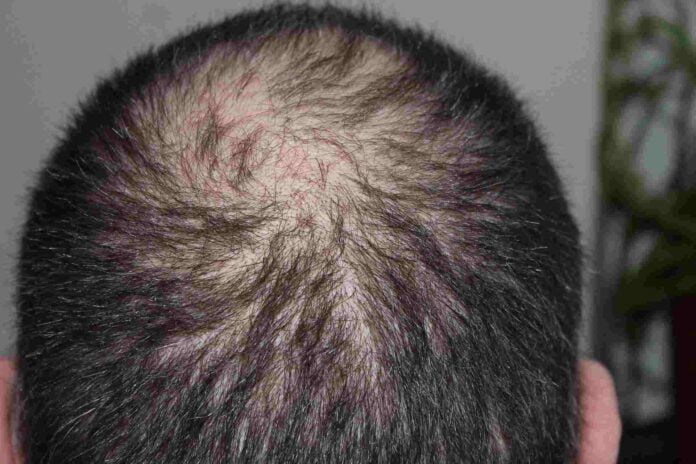Cicatricial alopecia, also known as “hair loss” or “baldness,” is a condition that causes excessive hair loss on the scalp. The most common causes of baldness are heredity, hormonal changes, medical conditions, or aging. However, men are more affected by this condition.
There are various types of baldness and some obvious signs that you may be balding.
Consult your doctor about the cause of your hair loss and your treatment options before pursuing treatment.
In this article, we will show you how to identify if you’re going bald (1, 2).
Evaluating Hair Loss
Hair loss can manifest itself in a variety of ways, depending on the cause. It can strike suddenly or gradually, and it can affect only your scalp or your entire body.
Therefore, inspect your hair in the mirror. The presence of hair on your pillow or in the shower drain does not imply that you are going bald.
The average person loses 50 to 100 hairs per day (3).
Because new hair is growing in, this is usually not noticeable. When new hair does not replace the hair that has fallen out, hair loss occurs.
Receding hair lines could show that you’re “going bald.” Other causes of patchy hair loss may exist.
Hair loss can be an indicator of other health problems, so it is critical to evaluate these other causes (4).
The following are some signs and symptoms of hair loss:
- Your top of the head is thinning gradually.
- Bald spots that are circular or patchy.
- Hair loss that occurs suddenly.
- Hair loss throughout the body.
- Scaling patches that spread across the scalp.
If you have noticed one or more of the above symptoms, consult your doctor. Also, talk to your doctor about early treatment for women who have a receding hairline (frontal fibrosing alopecia) to avoid significant permanent baldness (5).
Causes of Hair Loss
One or more of the following factors may cause hair loss:
Ancestral history (heredity). Hereditary reasons are the most common cause of hair loss. Both male and female pattern baldness are called androgenic alopecia (6).
This condition usually happens gradually and in predictable patterns, with men experiencing a receding hairline and bald spots and women experiencing thinning hair along the crown of the scalp.
Medications and supplements. Certain drugs, such as chemotherapy and radiation therapy, used to treat cancer, arthritis, depression, heart problems, gout, and high blood pressure, can cause hair loss (7).
Hormonal changes and diseases. There are many conditions that can cause temporary or permanent baldness. For example, hormonal changes caused by pregnancy, childbirth, menopause, and thyroid problems.
Alopecia areata, which is an immune-related condition that causes patchy hair loss, scalp infections such as ringworm, and trichotillomania, a hair-pulling disorder (8, 9).
A very stressful life event. Many people experience generalized thinning of their hair several months after a physical or emotional trauma.
This can occur due to the death of a spouse, divorce, marital separation from a partner, detention in jail, the death of a close family member, or being fired from work. However, this kind of hair loss is only temporary (10).
Treatments for hairstyles. Excessive hairstyling or hairstyles that pull your hair tight, such as pigtails or cornrows, can cause traction alopecia, a type of hair loss. In addition, some people use chemicals contained in hair straighteners and hot oil that can cause permanent hair loss (11, 12, 13).
Poor diet. A poor diet can lead to a scalp that lacks hair coverage. A lack of proper nutrition hampers the body’s ability to function. This can cause direct hair loss. It is possible that your hair loss is caused by your diet and can be treated with dietary changes (14).
Smoking. Smoking tobacco can harm your hair follicles. This can increase your chances of developing hair loss. Some studies show a relationship between smoking and male pattern baldness (14, 15).
Prevention
The majority of baldness is caused by genetics. You cannot prevent this type of hair loss, over which you have no control. You can either accept your body as it is or try to treat it.
The effectiveness of such treatments will be determined by your genetics, disposition, and financial resources.
While medical treatments have been effective sometimes, none of them will reverse male pattern baldness.
Hair transplants, also known as “hair plugs,” work by transplanting tiny clumps of skin from the back or sides of your scalp, each containing a few hairs.
These clumps are then inserted into balding areas of your scalp. This will not stop balding and may require additional treatments as your hair loss progresses.
Scalp reduction is a surgical procedure that removes some of the bald skin on your head. The bald skin is removed, and the hairy scalp is inserted (16, 17, 18, 19, 20, 21).
Conclusion
Some types of hair loss, such as cicatricial alopecia, are permanent, whereas others, such as stress or a medical condition, are only temporary.
Once the underlying cause has been identified and eliminated, your hair should regrow. Always take care of your hair.
When brushing and combing your hair, use a detangler and avoid tugging, especially if it is wet.
A wide-toothed comb may help prevent hair loss.
Also avoid hot rollers, curling irons, and hot-oil treatments.
Protect your hair from sunlight and other sources of ultraviolet light.
Last but not least, talk with your doctor about any medications or supplements you take that may cause hair loss.

